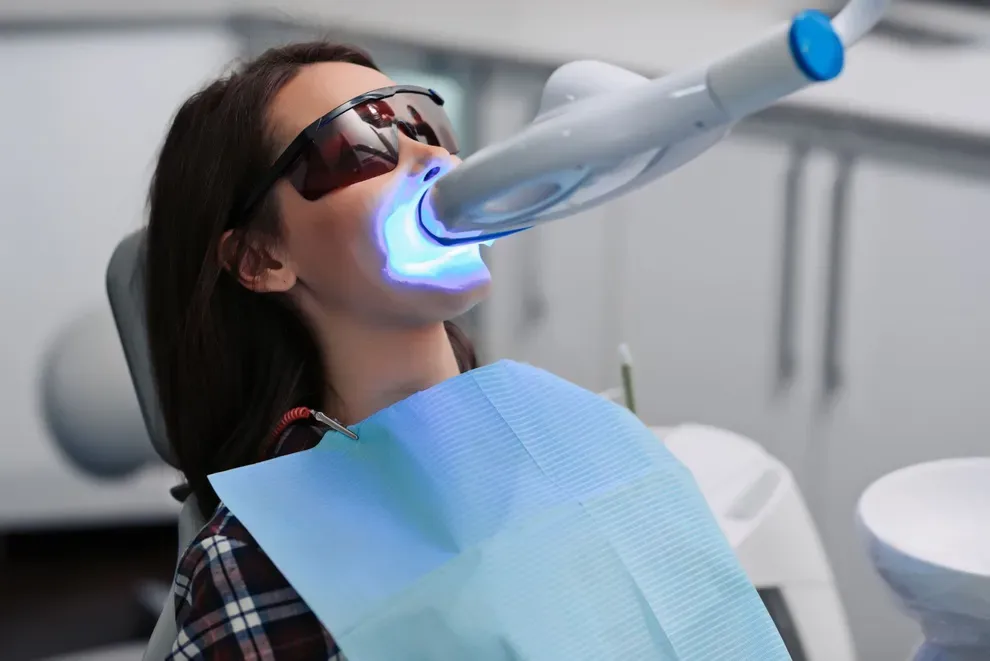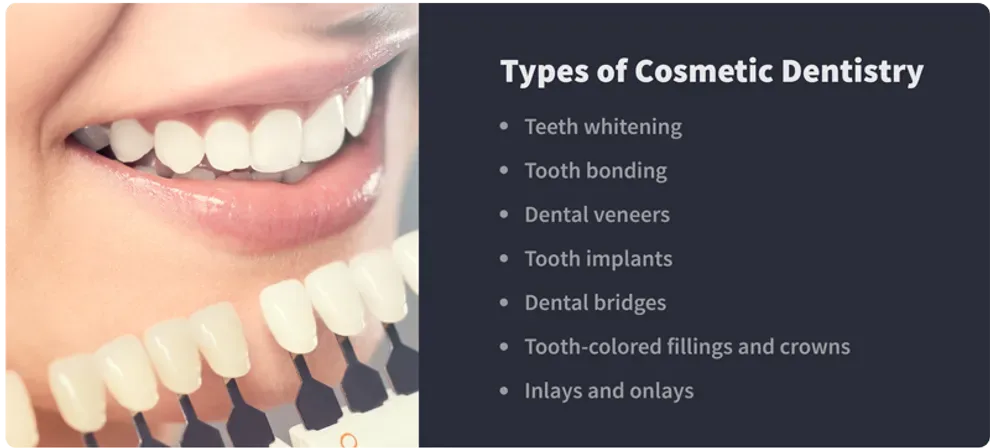What Is Cosmetic Dentistry? Types & Costs

Table of Contents
- Overview
- Types
- Why Cosmetic Dentistry?
- Potential Pitfalls
Cosmetic dentistry can give you a “smile makeover.” It can include teeth whitening, restoring damaged and discolored teeth, and restorative procedures.
Cosmetic dentistry aims to improve your appearance and self-confidence, and also to maintain function. There are a number of cosmetic procedures you can have done to enhance the aesthetics of your smile.
Typically, cosmetic dentistry is not considered medically necessary. As a result, it will not be covered by insurance. You will be responsible for the costs.
Improved self-esteem and a happier, healthier smile can be well worth the cost. The type of procedure you have done and where you have it done will define the price.
Understanding Cosmetic Dentistry
Cosmetic dentistry involves elective procedures to improve the look of your teeth and smile. It can include restoring, reshaping, or restructuring teeth as well as improving their color to cover discoloration or stains.
Cosmetic dentistry can help the way you feel about your teeth and smile, and this can enhance your mental health. Teeth are a big part of what determines the way a person sees themselves in the mirror, and cosmetic dentistry can greatly boost self-esteem.
Types of Cosmetic Dentistry

Cosmetic dentistry today is more than just teeth whitening and veneers. It also includes replacing missing teeth, restoring teeth function, and using many different avenues to enhance your smile.
These are some of the different types of cosmetic dentistry:
One of the most common complaints about a person’s smile is the color of their teeth. There are several approaches for whitening your teeth, including both at-home products and in-office treatments.
Cosmetic dentistry often involves in-office whitening treatments that can brighten up your front eight teeth by applying a special gel, all while protecting the rest of your mouth from these stronger products. Treatment results can last up to a year, and you will often follow up with home treatments.
This is one of the least expensive and easiest methods used in cosmetic dentistry to fix chipped teeth, close gaps, and reshape teeth. With dental bonding, the dentist will apply a tooth-colored resin and then bond it to the tooth using a special light.
The dental bonding materials and effects of the procedure will generally last between 3 and 10 years on average.
Veneers are placed on top of your teeth to improve the way they look. They can help to correct discoloration, cover chipped or crooked teeth, and fill gaps between teeth. There are a few different types of dental veneers, including both porcelain and composite resin, and there are pros and cons to each type.
Porcelain veneers are stronger and more resistant to staining, but they are more expensive and take more prep on the teeth before placing them. Porcelain veneers can last 10 to 15 years, while composite resin veneers typically remain in place for 5 to 7 years.
A dental implant is a type of prosthetic, typically made of titanium, that is fused in place to replace a missing tooth. It requires a surgical procedure to place. It is designed to integrate with the natural bone to function and appear most like the rest of your teeth.
A tooth implant is a major surgical procedure. It often requires the help of multiple specialists to ensure that the bone structure, gums, and prosthetics are aesthetically pleasing and also functional and medically sound.
A dental bridge is another way to replace one or more missing teeth. It involves creating a crown or implant on each side of the gap and filling it with false teeth in between.
Like an implant, a bridge is designed to be a permanent fix, and it is cemented in place. A dental bridge can be used to fix a gap where several teeth are missing. This can improve your smile and also help you to talk, eat, and smile more naturally.
Tooth decay can mean that you will need a cavity or even a crown after a root canal. Traditionally, crowns and fillings are silver and do not blend in with your teeth. Cosmetic dentistry can offer tooth-colored fillings and crowns that appear more like your natural teeth. These can be made out of a tooth-colored composite resin, glass, or porcelain.
A filling is designed to fill a hole left after a cavity is removed, while a crown is a kind of cap that helps to restructure or reshape a tooth that has more extensive damage. Porcelain and porcelain-fused-to-metal crowns are common cosmetic options that can be more aesthetically pleasing.
These fit inside the tooth and are used in place of a traditional filling or crown. An inlay is bonded to the tooth in place of a filling. In cosmetic dentistry, they are often made out of a composite material, ceramic, or porcelain.
Onlays are similar, but they also go on a back tooth to replace a cusp. Cosmetic dentistry uses tooth materials to best match the color of your tooth.
Some dental plans may cover a portion of the cost of specific cosmetic dentistry procedures, such as crowns, mainly when repairing a structural problem that could potentially disrupt your mouth's overall health.
Costs for Cosmetic Dentistry
| Procedure | Cost |
|---|---|
| Teeth whitening | $650 |
| Tooth bonding | $300 to $600 per tooth |
| Veneers | $925 to $2,500 per tooth |
| Implants | $3,000 to $5,000 per tooth |
| Bridges | $700 to$1,500 per tooth |
| Tooth colored fillings and crowns | $90 to $250 per tooth |
| Porcelain or porcelain- fused-to-metal crowns | $500 to $3,000 per tooth |
| Inlays | $250 - $1,000 per tooth |
| Onlays | $350 to $1,500 per tooth |
Cosmetic procedures are considered to be elective. Since they are not generally deemed medically necessary, they are not going to be covered by insurance. Most of the associated fees are going to be paid out of pocket.
While you may need a filling or a crown, getting one that is more aesthetically pleasing (tooth-colored) is going to cost more. This is considered cosmetic dentistry.
Many cosmetic dentists offer financing or payment plans. Often, dental discount plans can offer lower costs at certain providers as well.
Costs are going to partially be determined by where you live. Certain areas have higher prices. The type of procedure you want, and how difficult or extensive it is, will also influence the cost.
Average costs for common cosmetic dentistry procedures are as follows:
Teeth whitening: The average cost for in-office whitening treatment is around $650.
Tooth bonding: This costs around $300 to $600 per tooth on average.
Dental veneers: Porcelain veneers cost between $925 and $2,500 per tooth. Composite resin veneers usually cost between $250 to $1,500 per tooth.
Tooth implants: These cost around $3,000 to $5,000 per tooth on average, but sometimes, costs can be much higher.
Dental bridges: These typically cost between $700 and $1,500 per tooth, but there are rarely fewer than three teeth involved. Generally, it costs between $2,100 and $4,500 for a bridge.
Tooth-colored fillings and crowns: A composite resin filling usually costs between $90 and $250 per tooth. Porcelain or porcelain-fused-to-metal crowns can range in price from $500 to $3,000 each.
Inlays and onlays: On average, inlays cost between $250 and $1,000 per tooth. On average, onlays cost between $350 and $1,500.
Why Cosmetic Dentistry?
Over a quarter of people avoid showing their teeth when they smile for pictures on social media. Nearly half would change their smile first if they could change one thing about themselves, a study shows.
Cosmetic dentistry can improve your smile and the way you feel about it. This can raise your self-esteem and overall view of your personal appearance.
Teeth are easily stained with food and drinks. They can also be chipped or cracked and become decayed. Genetics may give you crooked or misshapen teeth or gaps that you are self-conscious about. Cosmetic dentistry can fix all this, serving as a type of makeover for your smile.
Potential Pitfalls of Cosmetic Dentistry
Cosmetic dentistry can improve your smile, but it can also come with significant cost and even risk. Treatments that are not medically necessary and aggressive can potentially damage healthy teeth and lead to structurally weakening them.
Cosmetic procedures have a shelf life. They will not last forever, and they often need to be redone at least once to maintain the look you want. Temper your expectations. Know what you want and the reality of actually achieving it.
Teeth whitening uses a highly corrosive bleach, for example, which can actually damage your enamel and cause tooth sensitivity. Reshaping teeth and placing dental prosthetics often involves some significant preparation of the area, which can involve shaving down an existing healthy tooth and therefore weakening it.
When looking to improve your smile, try to start with the least aggressive treatment method first. Elective procedures are not without risks. While they can be aesthetically pleasing, they can also do some harm.
Be sure to weigh the pros and cons, and research the procedure thoroughly. Follow all of the instructions given, and talk to your cosmetic dentist about your concerns and expectations ahead of time.
